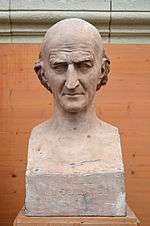Antoine Laurent de Jussieu
Antoine Laurent de Jussieu (French pronunciation: [ɑ̃twan loʁɑ̃ də ʒysjø]; 12 April 1748 – 17 September 1836) was a French botanist, notable as the first to publish a natural classification of flowering plants; much of his system remains in use today. His classification was based on an extended unpublished work by his uncle, the botanist Bernard de Jussieu.
Antoine Laurent de Jussieu | |
|---|---|
 | |
| Born | 12 April 1748 |
| Died | 17 September 1836 (aged 88) |
| Nationality | |
| Known for | Classification of flowering plants |
| Scientific career | |
| Fields | Botany |
| Institutions | Jardin des Plantes |
| Author abbrev. (botany) | Juss. |


_-_Walters_54834.jpg)
Life
Jussieu was born in Lyon. He went to Paris to study medicine, graduating in 1770. He was professor of botany at the Jardin des Plantes from 1770 to 1826. His son Adrien-Henri also became a botanist.
In his study of flowering plants, Genera plantarum (1789), Jussieu adopted a methodology based on the use of multiple characters to define groups, an idea derived from naturalist Michel Adanson. This was a significant improvement over the "artificial" system of Linnaeus, whose most popular work classified plants into classes and orders based on the number of stamens and pistils. Jussieu did keep Linnaeus' binomial nomenclature, resulting in a work that was far-reaching in its impact; many of the present-day plant families are still attributed to Jussieu. Morton's 1981 History of botanical science counts 76 of Jussieu's families conserved in the ICBN, versus just 11 for Linnaeus, for instance. Writing of the natural system, Sydney Howard Vines remarked
"The glory of this crowning achievement belongs to Jussieu: he was the capable man who appeared precisely at the psychological moment, and it is the men that so appear who have made, and will continue to make, all the great generalisations of science."[1]
In 1788, he was elected a foreign member of the Royal Swedish Academy of Sciences. He was a member of the Masonic Lodge, Les Neuf Sœurs.
Selected publications
- Jussieu, Antoine Laurent de (1789). Genera plantarum: secundum ordines naturales disposita, juxta methodum in Horto regio parisiensi exaratam, anno M.DCC.LXXIV (in Latin). Paris. OCLC 5161409.CS1 maint: ref=harv (link)(translated into French, with revisions, by Ventenat (1799) as Tableau du règne végétal selon la méthode de Jussieu)
- Jussieu, Antoine Laurent de. Opuscules de botanique. Retrieved 2009-08-19.
- Principes de la méthode naturelle des végétaux. París, 1824.
- 1770 : An aeconomiam animalem inter et vegetalem analogiae ou Comparaison de la structure et des fonctions des organes végétaux avec les phénomènes de la vie animale (Thèse défendue devant la faculté de médecine de Paris)
- 1773 : Mémoire sur la famille des renonculacées In: Histoire de l'Académie Royale des Sciences. Année 1773. Paris 1777, p. 214–240.
- 1774 : Exposition d'un nouvel ordre de plantes adopté dans les démonstrations du Jardin royal In: Histoire de l'Académie Royale des Sciences. Année 1774. Paris 1777, p. 175–197.
- Examen de la famille des Renoncules. In: Histoire de l'Académie Royale des Sciences. Année 1773. Paris 1777, pp. 214–240
Legacy
The system of suprageneric nomenclature in botany is officially dated to 4 Aug 1789 with the publication of the Genera Plantarum (Gen. Pl.).[2]
See also
References
- Vines, Sydney Howard (1913). "Robert Morison 1620—1683 and John Ray 1627—1705". In Oliver, Francis Wall (ed.). Makers of British botany. Cambridge University Press. pp. 8–43.
- Meerow et al. 2007.
- IPNI. Juss.
Bibliography
- Stevens, Peter Francis (2013). The Development of Biological Systematics: Antoine-Laurent de Jussieu, Nature, and the Natural System. Columbia University Press, 2013. ISBN 978-0231515085. Retrieved 4 February 2014.
- Meerow, Alan W.; Reveal, James L.; Snijman, Deirdre A.; Dutilh, Julie H. (November 2007). "(1793) Proposal to conserve the name Amaryllidaceae against Alliaceae, a "superconservation" proposal". Taxon. 56 (4): 1299–1300. doi:10.2307/25065925. JSTOR 25065925.
- Duane Isely, One hundred and one botanists (Iowa State University Press, 1994), pp. 118–120
- Herbermann, Charles, ed. (1913). . Catholic Encyclopedia. New York: Robert Appleton Company.

Wikimedia
| Wikisource has original works written by or about: Antoine Laurent de Jussieu |
| Wikimedia Commons has media related to Antoine-Laurent de Jussieu. |